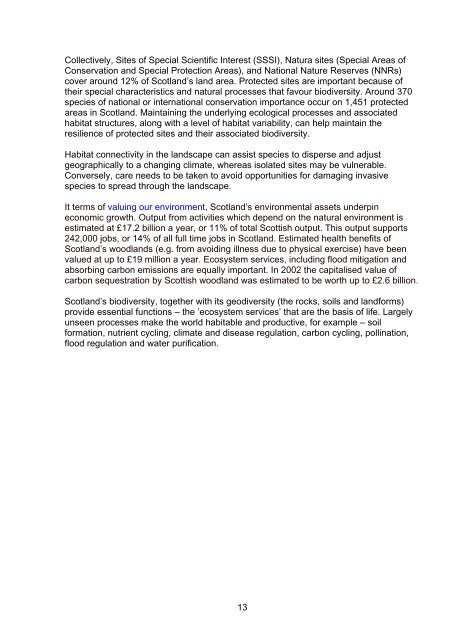Scotland's Wildlife â an assessment of biodiversity in 20
Scotland's Wildlife â an assessment of biodiversity in 20
Scotland's Wildlife â an assessment of biodiversity in 20
Create successful ePaper yourself
Turn your PDF publications into a flip-book with our unique Google optimized e-Paper software.
Collectively, Sites <strong>of</strong> Special Scientific Interest (SSSI), Natura sites (Special Areas <strong>of</strong><br />
Conservation <strong>an</strong>d Special Protection Areas), <strong>an</strong>d National Nature Reserves (NNRs)<br />
cover around 12% <strong>of</strong> Scotl<strong>an</strong>d’s l<strong>an</strong>d area. Protected sites are import<strong>an</strong>t because <strong>of</strong><br />
their special characteristics <strong>an</strong>d natural processes that favour <strong>biodiversity</strong>. Around 370<br />
species <strong>of</strong> national or <strong>in</strong>ternational conservation import<strong>an</strong>ce occur on 1,451 protected<br />
areas <strong>in</strong> Scotl<strong>an</strong>d. Ma<strong>in</strong>ta<strong>in</strong><strong>in</strong>g the underly<strong>in</strong>g ecological processes <strong>an</strong>d associated<br />
habitat structures, along with a level <strong>of</strong> habitat variability, c<strong>an</strong> help ma<strong>in</strong>ta<strong>in</strong> the<br />
resilience <strong>of</strong> protected sites <strong>an</strong>d their associated <strong>biodiversity</strong>.<br />
Habitat connectivity <strong>in</strong> the l<strong>an</strong>dscape c<strong>an</strong> assist species to disperse <strong>an</strong>d adjust<br />
geographically to a ch<strong>an</strong>g<strong>in</strong>g climate, whereas isolated sites may be vulnerable.<br />
Conversely, care needs to be taken to avoid opportunities for damag<strong>in</strong>g <strong>in</strong>vasive<br />
species to spread through the l<strong>an</strong>dscape.<br />
It terms <strong>of</strong> valu<strong>in</strong>g our environment, Scotl<strong>an</strong>d’s environmental assets underp<strong>in</strong><br />
economic growth. Output from activities which depend on the natural environment is<br />
estimated at £17.2 billion a year, or 11% <strong>of</strong> total Scottish output. This output supports<br />
242,000 jobs, or 14% <strong>of</strong> all full time jobs <strong>in</strong> Scotl<strong>an</strong>d. Estimated health benefits <strong>of</strong><br />
Scotl<strong>an</strong>d’s woodl<strong>an</strong>ds (e.g. from avoid<strong>in</strong>g illness due to physical exercise) have been<br />
valued at up to £19 million a year. Ecosystem services, <strong>in</strong>clud<strong>in</strong>g flood mitigation <strong>an</strong>d<br />
absorb<strong>in</strong>g carbon emissions are equally import<strong>an</strong>t. In <strong>20</strong>02 the capitalised value <strong>of</strong><br />
carbon sequestration by Scottish woodl<strong>an</strong>d was estimated to be worth up to £2.6 billion.<br />
Scotl<strong>an</strong>d’s <strong>biodiversity</strong>, together with its geodiversity (the rocks, soils <strong>an</strong>d l<strong>an</strong>dforms)<br />
provide essential functions – the ’ecosystem services’ that are the basis <strong>of</strong> life. Largely<br />
unseen processes make the world habitable <strong>an</strong>d productive, for example – soil<br />
formation, nutrient cycl<strong>in</strong>g, climate <strong>an</strong>d disease regulation, carbon cycl<strong>in</strong>g, poll<strong>in</strong>ation,<br />
flood regulation <strong>an</strong>d water purification.<br />
13
















